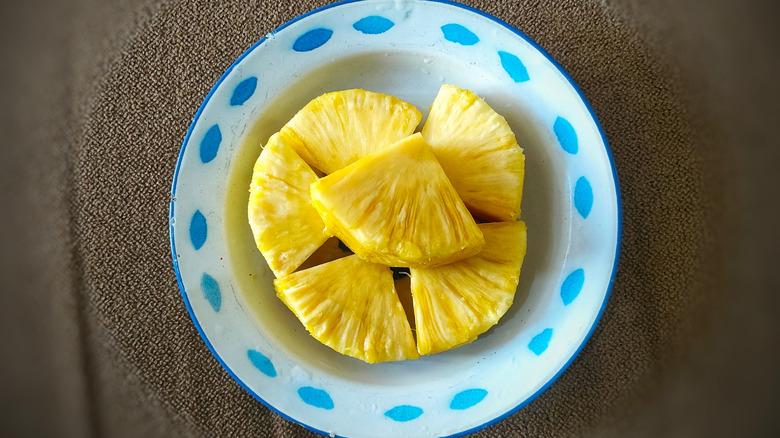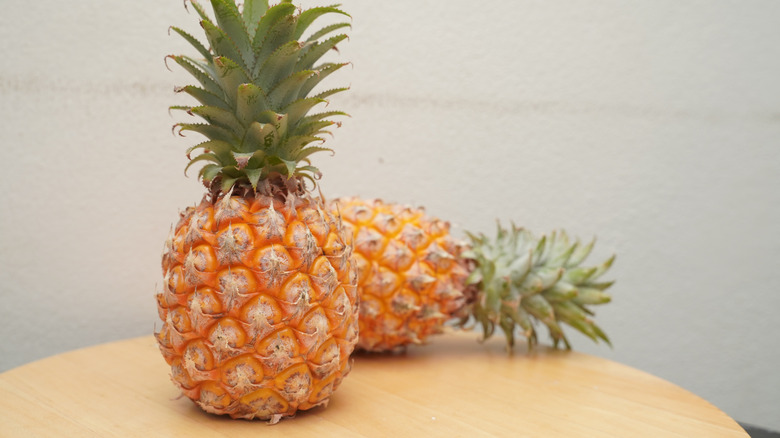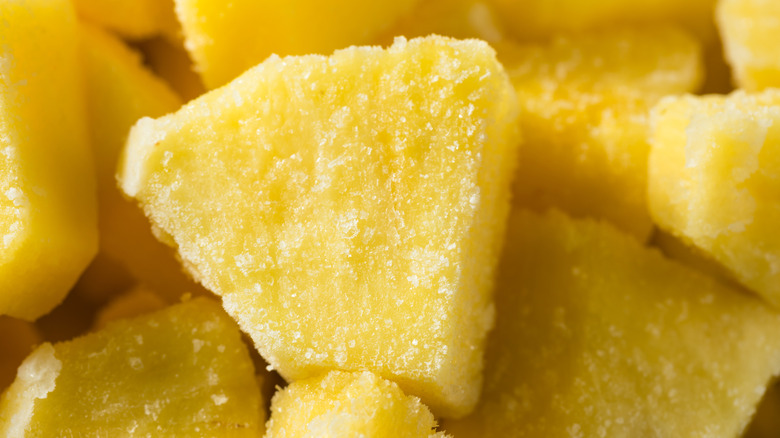The Best Way To Store Cut Pineapple So It Lasts
Since it's peak season for pineapple, picture this: You slice up the fruit, place it on a plate, and put it in the back of your fridge so you have something healthy to snack on for the week. However, two days later, the slices have already turned sour, mushy, and unappetizing. What could have gone wrong here?
If you haven't noticed yet, pineapple is a delicate fruit even if its outer skin appears tough. A whole, ripe pineapple will only stay good for three days when left out on the counter. When cut, it goes bad even faster. Once its flesh has been exposed to air, moisture loss and oxidation happen rapidly, leaving the fruit dull and spoiled in no time.
To counter this, proper storage is key. After slicing the fruit into chunks, rings, or spears, put the pieces in an airtight container. If you're using a resealable bag, minimize air exposure by pressing out as much air as possible before sealing the bag, then refrigerate immediately. This allows the sliced pineapple to last for five days in the refrigerator without ruining its juicy, sweet bite. Never wrap a pineapple in aluminum foil, as metal reacts to the fruit's acidity. Use BPA-free plastic or glass containers instead.
How to store whole, uncut pineapples
Cut pineapple has a shorter shelf life than whole pineapples, but you can't expect the latter to last for much longer, especially when not stored properly. A common mistake people make is thinking refrigerated, uncut pineapple will last virtually forever.
A whole pineapple can stay viable for three to five days at room temperature. If you want to extend its shelf life, store the pineapple in the fridge, but don't put it in the crisper. Instead, place it on one of the shelves where it will last a week. If space is an issue, you can remove the fruit's leafy crown. To do this, you don't need to use a knife. Just grab the leaves firmly and twist off the crown.
Proper storage can actually make pineapple effortlessly sweeter. After de-crowning the fruit, cover it with plastic wrap and put it upside down on a plate. After a few days, the juices that typically gather at the bottom of the fruit will have spread throughout the whole pineapple.
Storing pineapples long-term
In case you find yourself with more pineapple than you and your family can eat before it goes bad, freezing what's left is a smart way to extend the fruit's shelf life by months. You can use frozen pineapple in all sorts of things, including smoothies, cocktails, baked goods, and savory dishes like sauces and stir-fries. If you're not doing it yet, you should also start adding pineapples to fish sandwiches. However, do note that the fruit's texture may change slightly after thawing. Its flavor should remain the same, nonetheless.
To freeze excess pineapple, cut it into chunks or slices depending on your preference and arrange them individually on a parchment-lined baking sheet or plate. Be sure the pieces don't touch so they don't stick together to form clumps in the freezer. Once everything's frozen solid, transfer the chunks into a zip-top bag or an airtight container. To save space, flatten the bag before sealing. You can portion the pieces and store them in different bags if you intend to use them in different ways.
Never freeze a whole pineapple, regardless of whether you peeled it or not. The dense core of the fruit and its thick skin will not freeze thoroughly, making thawing a struggle. Also, think twice before throwing out pineapple rinds because you can actually use them to make the fermented drink tepache.


